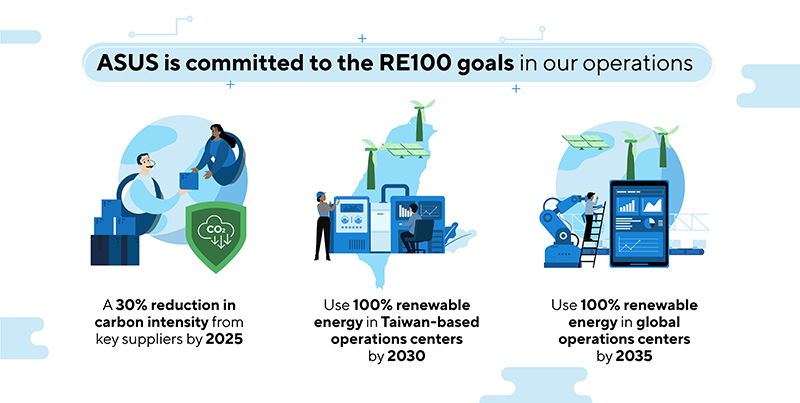Enterprise sustainability: How tech and innovation can help humankind save the planet

Corporations around the world are threatening our planet by burning fossil fuels for electricity and heat in excess. Among them, manufacturing and construction are the third-largest contributors of heat-trapping emissions, contributing as much as 13.3% of carbon emissions, according to the World Resources Institute1. Besides hurting our planet, failure to achieve climate change mitigation goals, as specified in the Paris Agreement, may lead to the global economy losing trillions of dollars (USD) by the next century2.
According to Gartner3, renewable energy sources and energy efficiency will only address around 55% of “net zero” greenhouse gas reduction goals. In order to meet the 2050 global goal, we will need microgrids, energy harvesting technology, and organizations that adopt asset optimization strategies.
As manufacturers, the onus is on us to create a sustainable future both for our children and for theirs. So how can we enable long-term, successful sustainability programs?
It begins with every leader and their IT organization. Most enterprise sustainability and ESG programs are data and technology intensive. In fact, 63% of enterprise CIO respondents in a Gartner survey indicated that investments in IT and digital solutions are part of their sustainability programs4.
This means that leaders have an immense responsibility to actively enable and helm their company’s sustainability program from strategy to execution. This obligation grows considering how much strategic value sustainability data has for business planning too.

Leaders can approach their enterprise sustainability strategy with a two-pronged measure: (1) mitigation and (2) adaptation. Mitigation includes reducing emissions, while adaptation includes modifying your enterprises’ operations and processes with the understanding that the climate will change.
All of this is why ASUS has committed to upholding the following tenets of sustainable manufacturing:
Mitigation
Mitigating our immediate impact on the environment is the first step.
Many companies have set targets consistent with the Paris Agreement5. Yet progress has been negligible, even during the significant pandemic slowdown. The United Nations has reported that the 7% dip in carbon dioxide emissions due to the pandemic only translates to a 0.01°C reduction of global warming by 2050. In addition, the UN has called existing climate pledges “woefully inadequate”6.
Actual policies must therefore be specifically formulated for each enterprise’s unique journey. For instance, each company under the 2-degree Celsius framework (where nearly 200 countries agree to limit global warming to no more than 2 degrees Celsius by 2100) would face different financial risks and opportunities in response to carbon taxes, and renewable energy and energy-efficiency laws for their supply chains, operations, and products. This is where technology comes into play. Running qualitative and quantitative scenario simulations, like the ones ASUS does for its clients, can help enterprises develop achievable, individualized climate strategies.

We believe in walking the talk; we’ve formulated new climate action targets based on our scenario simulations and recently reduced our emissions intensity at our facilities7. These targets include reducing 50% of carbon emissions from ASUS global operation centers by 2030. As a new member of RE100 (a global renewable energy initiative to achieve 100% renewable energy with over 300 corporate members), we will also be using 100% renewable energy in our global operations centers by 2035. Additionally, by 2025, we aim to achieve a 30% reduction in the carbon intensity of our key suppliers and ensure that our products have average energy efficiencies that exceed the ENERGY STAR® standard by 30%8. Currently, our recycling services cover more than 77% of our sales market and we have recycled over 12,000 tons of e-waste as of 20209.
With the right partners and technology, building a low-carbon business can be a seamless transition.
Adaptation
Beyond mitigating our immediate environmental impact, we need to adapt how we produce. Notably, customers and regulators are the main forces pressuring enterprises into action. For example, 73% of Gen-Z consumers are more willing to spend on sustainable products10. In Asia, 65% of the pressure on enterprises to invest in sustainability initiatives comes from regulators11. From ethical production to supply chain transparency, there is a wide range of strategies we can use to adapt our processes to meet the requirements of this new sustainable world.
Participating in the circular economy
Our present economic model is built on a "take-make-dispose" process that has led to immense growth but also immense waste leading to ecological deterioration and pollution12. Fortunately, a circular economy can unlock more sustainable operations and ways of consumption.
What is a circular economy? Traditionally, products follow a linear value chain in which everything is disposed of at the end of its life and all value is lost. In contrast, a circular economy creates loops in the linear system to retain as much value as possible13. It goes beyond just recycling and includes secondary life uses, refurbishment, and parts harvesting. The cherry on top is that a circular economy could potentially yield up to US$4.5 trillion in economic benefit by 203014.
ASUS participates in the circular economy by donating refurbished computers to underserved communities to reduce waste while also bridging the digital divide, among other initiatives. Fundamentally, waste is a result of misplaced resources, and our Refurbished Computer and Digital Training program in Taiwan gives new life to otherwise unusable products15. We also provide computer recycling services to 74% of markets globally and commercial computers are made from at least 5% recycled plastics16. Waste created during production is treated and recycled to reduce our impact.
Unfortunately, the world still has a long way to go: only 8.6% of the global economy today is considered circular17.
Embody responsible manufacturing
Being responsible encompasses being accountable for both our environmental and social impact.
Proactive management strategies, like how ASUS prohibits hazardous chemicals and uses big data to optimize hazardous-substance management in real-time, are one way of being accountable for our products. We eliminated the use of halogen flame retardants in the ASUS ExpertBook B9, for example, and ensured that the packaging is made from paper certified by the Forest Stewardship Council. The ExpertBook B9 is also 67% lower than the ENERGY STAR® standard — 67% is equivalent to charging 8,267 smartphones. More significantly, we believe that you can’t manage what you don’t measure. To hold ourselves accountable and set tangible targets, ASUS’ 2022 Sustainability Report lays out our sustainability progress and goals18.
Ensuring positive social impact also means protecting our vulnerable communities and having integrity in the way we source and use resources. Did you know that some metals like gold and tin are sometimes obtained by forced child labor, or are exchanged for weapons which encourage regional instability19?
The Responsible Business Alliance (RBA) Code of Conduct is a set of social, environmental, and ethical industry standards that manufacturers like ASUS base their supplier’s code of conduct on. This prohibits child labour and protects female employees during and after pregnancy. We also ensure raw material tracing to make sure 100% of the minerals we use are ethically sourced.
Invest in research and innovation
80% of executives in a Deloitte survey shared that their employees were very concerned about climate change, and nearly half of millennial employees in another survey would look to change jobs if their company did not implement sustainable business practices20.
In 2020, we established the Innovation Development Office. This office is responsible for establishing a systematic innovation management system and proposal platform for new ventures. It aims to increase R&D energy through collaboration with start-ups and in-depth industry-government-academic cooperation. For instance, we’ve teamed up with medical institutions, such as Tzu Chi Medical Foundation in Taiwan, to dive into AI foresight research and expand medical treatment possibilities. Innovation can also be built bottom-up; in 2019, we held our first creativity competition in Suzhou, China where employees explored business possibilities together. Ultimately, we believe in creating human-oriented experiences and designing with not just the end-user in mind but also the impact we make on our communities.
Accelerating our progress in tackling environmental and social sustainability will require exceptional collaboration and partnership that envisions us not as consumers or producers, but as caretakers of our communities and planet.
This begins with understanding the risks and opportunities of our climate, environmental, and social impact; responding with transparency and accountability; and integrating sustainability mechanisms into our business decisions and transformation. Together with our partners and customers, we can do better.
- Windows 11 Pro - ASUS recommande Windows 11 Professionnel pour les entreprises
- Processeur Intel® Core™ i7 jusqu'à la 12e génération
- Jusqu’à la carte graphique Intel® Iris Xᵉ
- Le premier PC portable professionnel de 14'' au format aussi léger
- Jusqu'à 16 heures d’autonomie
- Une sécurité de niveau professionnel pour une protection renforcée
- Compatible avec la plateforme Intel vPro
- Windows 11 Pro - ASUS recommande Windows 11 Professionnel pour les entreprises
- Proceseur Intel® Core™ i7 jusqu'à la 12e génération
- Carte graphique allant jusqu'à la NVIDIA® GeForce® GT1030
- Châssis sans outils
- Jusqu'à 64 Go de mémoire
- Jusqu’à un stockage HDD de 4 To + SSD de 2 To
- Two-way AI noise-canceling
1. CNN, 10 climate change villains, 2019
2. Self-preservation strategy for approaching global warming targets in the post-Paris Agreement era, 2020
3. ASUS, Corporate Social Responsibility, 2022
4. Gartner, 5 Key Steps for CIOs to Drive ESG Initiatives, 2021
5. Deloitte, Leading in a low-carbon future, 2021
6. UN Environment Programme, Emissions gap report 2020, 2020
7. United Nations Climate Change, The Paris Agreement, 2021
8. ASUS, ASUS Achieves Climate Leaders Asia-Pacific 2022 Recognition, 2022
9. Nikkei Asia, Asia-Pacific climate leaders: Which companies cut emissions?, 2022
10. World Economic Forum, Why sustainability is crucial for corporate strategy, 2022
11. Gartner, The Role of the CIO and Technology in the Enterprise Sustainability and ESG Endeavor, 2021
12. McKinsey, The circular economy: moving from theory to practice, 2016
13. McKinsey, Why the circular economy is all about retaining value, 2016
14. EY, How redefining the circular economy could reshape a sustainable planet, 2021
15. ASUS, Social Investment Strategy
16. ASUS, Corporate Social Responsibility
17. EY, How redefining the circular economy could reshape a sustainable planet, 2021
18. ASUS, 2020 Sustainability Report, 2022
19. ASUS, Corporate Social Responsibility, 2022
20. Deloitte, Climate Change 101 for business leaders, 2021

